Leica M9 Digital Rangefinder Camera - Page 4 Index of Thorsten Overgaard's user review pages on Leica M9, Leica M9-P, Leica M-E, Leica M9 Monochrom, Leica M10, Leica M10-P, Leica M10-D, Leica M10-R, Leica M10 Monohcrom, Leica M11, Leica M11-D, Leica M 240, Leica M-D 262, Leica M Monochrom 246, Leica SL, Leica SL2, Leica SL2-S, Leica SL3, Leica SL3-S as well as Leica TL2, Leica CL, Leica Q, Leica Q2, Leica Q2 Monochrom, Leica Q3 and Leica Q3 43:
One week in London with seven pairs of socks, five t-shirts and one Leica M9
By: Thorsten Overgaard
I was in London for a week to shoot some assignments and brought with me a Pelican case filled with Leica R9/DMR dSLR and lenses, plus a Leica Digilux 2. I also had reflectors, LED lights and monopod, a bag full of chargers, batteries and converters. And then casually over the shoulder, the Leica M9.
The irony of it all was that all I used the whole week was the Leica M9 and a 35mm and 50mm lens. The rest of the gear was unused (apart from a single shoot where I used the Leica R9/DMR for backup). I did have a 21mm SA f/3.4 and a 90/2.8 in the Pelican case but never took them out. The 50mm Noctilux-M f/1.0 and 75mm Summicron-M ASPH f/2.0 pictures are with a lens on loan from one of my photo seminar students while we were out shooting in London.
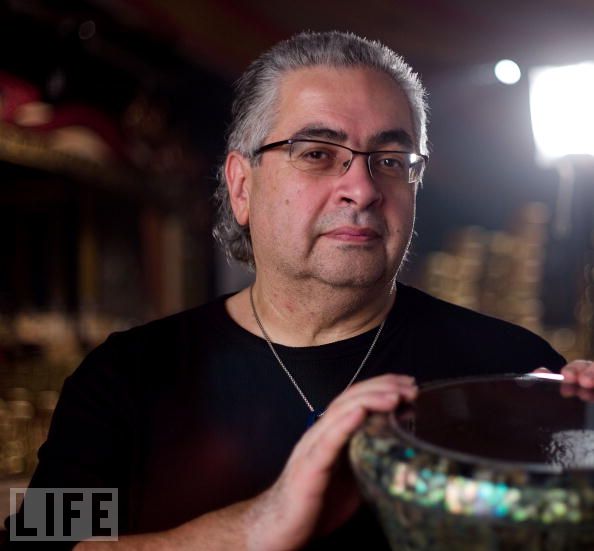
Percussionist Hossam Ramzy of Led Zeppelin photographed with Leica M9 and Leica 50mm Summicron-M f/2.0 at 400 ISO, manual white balance. Lit by two ARRI lights and one silver reflector.
What to bring
I've tried travelling through London on the Underground with a Pelican roller case in the past, and it's as unpractical as can be because of all the stairs up and down where a roller case doesn't work well. And then there's the constant change in temperature from the underground to street where any sort of clothing is a mess - especially if you carry 20-30 kilo of gear with you.
You feel like a donkey and you certainly don't get any pictures taken because you're so occupied with transporting things around.
This time I was commuting one hour every day from the suburbs to London which is why I had to make some executive decisions every morning: Should I wear a jacket with pockets or should I dress lighter and then have a bag, or should I dress lighter and simply just bring the most basic things? In most cases I took very little gear with me and ended up using just the M9 and one lens.

London street with Leica M9 and 75mm Summicron-M ASPH f/2.0 (shot as black and white JPG and color DNG in camera).
Leica M9 - could it be just as simple as that?
Walking around with merely a small Leica M9 and basically just the choice of a 50mm and 35mm lens, I discovered that I felt best with just one lens. I would use just the 35mm throughout the day and the 50mm would stay in the pocket. It's funny, because when I do my photo seminars, I give homework and assignments saying, to use just one lens, so as to train the eye to look for "35mm frames" or "80mm frames" or whatever the choice one made was. Zoom lenses are confusing because you always see a picture before you take it.
A zoom prevents you from seeing the picture, predict it and get it. It will always be a question "How much should I zoom?" when you bring the camera in front of your eye. It's wrong, instead you have to think with the frame you got and position yourself. With just one lens life becomes simpler and you have to work with what you get, and you will start seeing things from the viewpoint of that lens.
In any case, the question is if you should bring a load of equipment to make sure to get the shot ... or can you actually get it with what you got, even if it's only one camera and one lens? As it turns out, I think the answer is that you can do pretty much anything with just one camera and a lens or two.

London street with Leica M9 and 75mm Summicron-M ASPH f/2.0.

London street with Leica M9 and 75mm Summicron-M ASPH f/2.0, 200 ISO, 1/250 second.
But all those nice cameras and lenses
I visited the Leica flagship store in Mayfair where I had a look at M lenses and the Leica S2. And let me just say the Leica S2 is tempting. It's an odd detail to remember, but on most SLR cameras there's a button to release the aperture so as to preview the DOF, and it's usually like pushing a train. On the Leica S2, there's a small button that triggers the aperture electronically; it doesn't require any effort. But more interestingly I had a look through the viewfinder at the bokeh of the 70mm and I must say it looks really promising.
The official files from the S2 so far has been studio photographs with flash, and for some reason the target group of the S2 seems very occupied with counting hair in the models face. I know the whole medium format segment of photographers have an almost childish obsession with sharpness, but personally I can't wait to get out to a dark alley shooting with an S2. Because how does it capture the atmosphere and the light? That's the question I have.

Inside the Leica Store Mayfair with Leica M9 and 50mm Noctilux-M f/1.0, 400 ISO, 1/125 second.
The 21mm Summilux-M ASPH or the 24mm Summilux-M ASPH?
I had the opportunity to test the two new Summilux-M wide angle lenses since day one I had my eye on the 21mm. But everybody else seemed very impressed with the 24mm and that frankly confused me. So I wanted to test them both and see which one was the right one.

Depth of focus (DOF) Leica M9 and 21mm Summilux-M ASPH F/1.4 @ f/1.4, 80 ISO, 1/710 second.
What interests me is how they handle light. That is how a lens manages to make the reflections of light in surfaces, textiles, hair, eyes, skin, etc. come alive and "glow." Because that is what photography is about, and what the Leica glow is about. And as part of that is shooting against the light.
And then of course there is the DOF, depth of field: How does a wide angle lens that is traditionally sharp in most of the field behave when it's a Summilux f/1.4 wide angle lens that "suddenly" has selective focus?

Highlight and shadow with Leica M9 and 21mm Summilux-M ASPH f/1.4 @ f/1.4, 200 ISO, 1/4000 second.
As it turns out, both Summilux-M lenses handle light and details to a degree that is almost frightening. I was literally shaking of excitement when I handed the lenses back to the Leica Store Mayfair. Look at that picture above, how the sun bursts directly into the lens, and yet it maintains the details in the shadow without any fringing or "milky" light blowing out the shadow part of the image. I mean; that's almost unreal!

Leica M9 and 24mm Summilux-M ASPH f/1.4 @ f/1.4, 80 ISO, 1/2000 second. (You may notice the odd shape going into the building. I asked Leica in Solms what that was and was told it's appearing if the sensor is heavily overexposed, minimum 12 f-stops or more. Fair enough; I was glad it wasn't the lens or oil on my sensor or something).
Tool of the artist
Some may have noticed that the slogan Leica Camera introduced alongside the Leica M9 is "Tool of the Artist" and that is exactly what those Summilux-M lenses are. They allow you to see and capture things in ways else not possible. Because of the DOF, their handling of light and the way they render reflection details.

Leica M9 and 24mm Summilux-M ASPH f/1.4 @ f/1.4, 80 ISO, 1/250 second.
Frankly my test didn't solve the question if I like the 21mm or 24mm the best. Problem is I like them both. I like the wider view of the 21mm but prefer the slightly more narrow DOF of the 24mm. To me both feel the same size (though they're not) and both turn 45 degree from 0.7 meter focus to infinity focus. In the review by Steve Huff the 24mm seem better in capturing micro-details than the 21mm but I haven't been able to determine which is the case ... and perhaps it's not important.

The photo studio and seminar room upstairs in the Leica Mayfair store with Leica M9 and 24mm Summilux-M ASPH f/1.4 @ f/1.4, 400 ISO, 1/180 second, focused on the logo on the glass door at 70 cm.
| |
|
|
|
|
| |
Buy my "New Inspiration Extension Course"
|
|
| |
|
|
|
|
| |
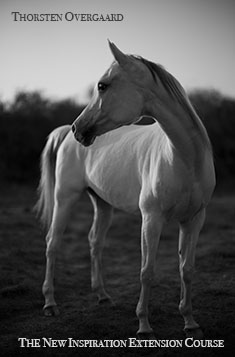
Need more info?
Read this article. |
|
Get inspired and rebooted!
This extension course if made for you! It can be done at home and travel at your own pace. I have taught workshops for years and the Overgaard New Inspiration Extension Course is my experience compressed to a package of training, articles, drills, assignments and video tutorials that will inspire you and take your photography to the next level! For a limited time my course includes something you cannot get anywhere or anytime else:
A portfolio-review by Thorsten Overgaard.
| |
|
|
| |
"The Overgaard
New Inspiration
Extension Course"
For computer and iPad. 181 p eBook. |
|
| |
Only $798 |
|
| |
|
|
| |
 |
|
| |
|
|
| |

|
|
| |
|
|
Order now - Instant delivery. |
|
| |
|
|
|
|
The Leica Mayfair embassy
It should be mentioned as a side-note that I was told in the Leica Store Mayfair that they saw themselves as a brand store, and as such anybody is welcome to come visit and see the Leica products, decide to buy, and then go buy it in any other store. Presenting the brand was what they were there for, not selling it in front of the established Leica dealers in London. I'm just mentioning this because I like Red Dot Cameras but I really don't like spending the shop owners time and then buy in another place. But in this case it's fine. I can take up their time in the Mayfair store and send my order to Red Dot Cameras or Meister in Berlin, which I think is fair for their hard work and years of supporting the Leica brand.

Inside the Leica Mayfair store with Leica M9 and 50mm Noctilux-M f/1.0, 400 ISO, 1/90 second.
Which lenses for the Leica M9..?
I know this is a question many have to ask themself. One reason is the change from the cropped sensor in the Leica M8 and Leica M8.2, where the 28mm suddenly was the new 35mm, to the full-frame sensor in the Leica M9 where the 35mm is again the 35mm. But also when you get the Leica M9 you become really occupied with blowing those 18MP files up to 100% on the screen and check for details, sharpness and fringing.
In essence, it doesn't matter how it looks in 100% on a screen. What matters is how it looks in an A4 print (8x12") or equivalent magazine print. Looking at 100% crops of pictures is a very bad habit, which has become almost an institution "thanks" to pages like dpreview and other reviewers who, in their lack of understanding of other qualities, try to measure, which is best. It's like measuring Picasso against Da Vinci. You can blow up their paintings and analyze the thickness of paint, but if that's all you do, you miss the full picture.
For cameras it's more interesting to talk about which camera you like the best, which feels the best, which one you would like to carry with you.
In lenses it's very much a matter of what atmosphere it can create but of course also how it feels working with it and if it can do the things you require it to do.

Leica M9 and 75mm Summicron-M ASPH f/2.0. You can actually read the subtitles on the television on the other side of the street if you blot up this picture:

100% crop of the above picture.
The digital age requires new lenses - or does it?
My first reaction when I looked at the Leica M9 files were that the old Leica M lenses, what I had was not good enough. Too much milky light, too soft details, too blurred micro-details. It really made me concerned looking at them!
But then after a few weeks when the analyzing phase was over and I started using the Leica M9 as a tool and had some knowledge about it and the ability to predict results by using it, I started wondering what kind of look I actually wanted.
The Leica Summilux-M f/1.4 is the classic example of this perhaps. The new 50mm Summilux-M ASPH f/1.4 is razor-sharp and has that "new" even bokeh without the "stop signs" (as Leica calls them, referring to the blurred highlights in the background of a picture shaped like a stop sign due to the shape of the aperture in the lens). But many prefer the old Leica 50mm Summilux-M, the "non-ASPH" as it is often referred to. Reason being that the "non-ASPH" has a more "film-like" or "classic" look, and perhaps is more gentle to the face of the people you photograph (since not that many people above the age of 25 see razor-sharp wrinkles in their faces as a quality). It's not unusual that some Leica users have both those lenses because they have some outstanding qualities.
One important feature in the new lenses - near focus range
One thing I find rather important is that the near focus range has improved in many of the new lenses so that for the most part, it has improved to 70 cm where it was often before 100 cm. It makes a huge difference if you can move in 100 cm or 70 cm with a 50mm or 35mm lens. And for the new Summilux-M ASPH 24mm and 21mm it's mandatory in order to use the DOF for real dramatic effects. So even when looking at older lenses, check which edition you are looking at, and what the near focus range is.
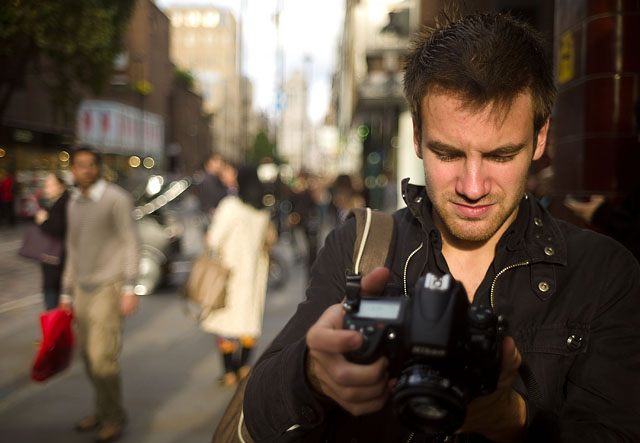
Leica M9 and 35mm Summicron-M f/2.0 @ f/2.0, 200 ISO, 1/710 second.
Perfection or Unique?
What I look for in photography is a unique look, but at the same time a level of perfection. The perfection part is sharpness, micro details, straight lines, resolution, color accuracy and rather technical stuff you can usually measure. And you could say the sturdiness or the equipment is also such a quality that you can measure. To some, the measureable quality of being the most expensive kit could also be a quality.
But then there is the real qualities, which distinguish cameras and lenses. The first one is the love factor, which in its most simple form is the camera of them all in the camera store you really want. You know when you meet a fellow with his Canon 5D Mark XIII and all he wants to talk about is your Leica, that there's a fellow who's not with his real love. Because love factor in a camera is the one you dream of having and which will never really leave your side once you get it. It's simple and beyond what any dpreview can measure.
But what is really interesting in lenses (and cameras) is the look. I've never managed to admire the fact that 20 photo journalists with each their Canon 1Ds Mark XVII and the 70-200/2.8 could capture the exact same picture. What I can admire is the different location, the different angle, the different light; the personal look of someone who thought about it and made his own viewpoint into a photograph.
Equipment can help one in doing that, the Leica 80mm Summilux-R f/1.4 being a great example with it's extremely narrow depth of field, dreamy look and bokeh.
But when you get a new Leica M9 the game is how well it handles high ISO, how sharp the files are, how broad the dynamic range is and how fast the buffer is. In reality none of which qualities make a great photo on it’s own.

Two of my photo seminar students, John Amedick and Tom Sung shot in Green Park in London with Leica M9 and 35mm Summicron-M f/2.0 (version I anno 1960). You will notice the photo is out of focus...
What I have learned in life so far
What I look for - apart from the love factor - is which lenses I can use to create the expression and atmosphere I look for, and do so "in camera" without Photoshop aid (meaning the picture is complete when taken). It doesn't have to be very super-special though it's definitely a different look from the results you mostly get from a 70-200mm f/2.8 Canon zoom.
After coming over the analyzing phase I've started to appreciate again the look of the older Leica lenses. Those, which are a bit milky, not as clean in the micro-details and all. Because they have some qualities, which might best be described as a "classic" look, "film feel," "historic look" or simply the look of the year they were made.

Leica M9 and 35mm Summicron-M f/2.0 (version I), 200 ISO, 1/710 second.
I remember some years ago, I thought lenses were like high fidelity, the older the better. But fact is that photography evolves. The slide films of today are so much better than the ones of the past. And the lenses of today are so much better than the older ones. I don’t know about any Nikon lenses where I see people seek for the old Nikkor lenses for better results, but in Leica lens development it's absolutely true that the new lenses perform better than the previous ones. And when you get a digital file you can tell. The micro details of a Leica ASPH lens is incredible detailed and sharp. How they manage to design and produce lenses that can control light rays this precise ... I simply can't comprehend. But they can and they do.

Leica M9 and 75mm Summicron-M ASPH f/2.0 @ f/2.0. You can actually read the text in the newspaper when you blow up this photograph. Here is a photo from the same series:

100% crop for show. What we really need them for, I don't know.
The "Know your equipment" - Factor
Hence the obvious conclusion is to get the newest, best and most sharp lenses to go with the detailed sensor of the Leica M9. But that is where I've kind of stopped time and try to come to my senses. Because I see some qualities in the older lenses which I like, but definitely also some in the new ones.
On top of that, the Leica M9 experience since September 9, 2009 has shown me that there's a camera with that love factor, so few and intuitive controls, and an image quality, which might do the job. And considering the size of the Leica M9 and a few lenses, it might blow the Leica S2 and Leica R9/DMR out of the water.
 Leica M9 with 50mm Summicron-M f/2.0 (version 1962) @ f/2.0, 800 ISO, 1/60 second, manual white balance. Leica M9 with 50mm Summicron-M f/2.0 (version 1962) @ f/2.0, 800 ISO, 1/60 second, manual white balance.
Fact is, that statistically there are 1,4 lenses sold per Leica M camera which gives you an indication that - apart from the many Leica M6 cameras with a 35mm lens lying unused in closets around the globe - there a very few Leica M photographers who have a lot of lenses. I bet the average number of lenses is a lot higher for Leica R cameras and other SLR cameras.
You will hear many Leica M photographers claim that they do most of their photography with one lens and only occasionally use their others. I would say that anyone shooting for a living will meet a variety of assignments requiring a bit more than one lens.

Leica M9 and 50mm Summicron-M f/2.0 (version 1962) @ f/2.0, 800 iSO, 1/60 second.
But let's just play with the idea that my M outfit would be a 21mm, 50mm and 75mm. And let's add a 35mm just for classic reasons. With that kit I could more or less carry all my equipment at me, at all times and still do almost all the assignments I do with a Leica R9/DMR and the range of 19-400 mm lenses.
Now, that is a pretty tempting thought when you ride the metro or pass through the airport security! And that is what makes me say the Leica M9 might blow the Leica S2 and all other cameras out the water.
The interesting part, when you get to know the Leica M9, is that it's a rather complete camera. It doesn't shoot 8 frames per second, and if you require to shoot a lot (more than the buffer allows), you got to have two bodies to switch between, and it doesn't do above 135mm tele shots that easily. But at what it does, it's a great camera.
I believe in getting to a point where you know your equipment that well that you can foresee the end result before you take the picture. And the point is, that a simple camera as the Leica M9 allows you to. You have very few things to pay attention to and are very much in control of it all. So in that way, you can rather easily become a professional in the sense of the word that you can produce a predictable result which can be used for the purpose or perhaps even impress the viewer.

Leica M9 and 50mm Summicron-M f/2.0 (version 1962) @ f/2.0, 800 ISO, 1/60 second.
I've been standing next to photo journalists equipped with two Nikon D3 cameras who still struggled with finding out which buttons did what. In other words, if that's the scene, you have no idea what you will end up with, why you'll have to trust the automaticity and shoot enough frames so that at least one is usable for the paper.
There's not much love factor about that situation, and I think one should take that love factor into consideration no matter if one does if for a living or as a hobby.
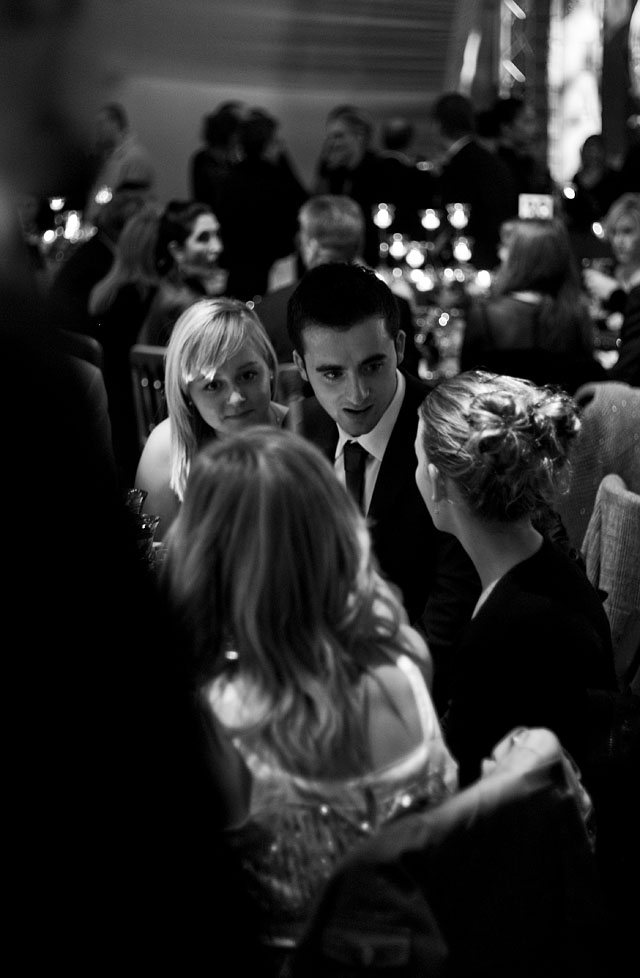
Table decoration with Leica M9 and 50mm Summicron-M f/2.0 @ f/2.0, 800 ISO, 1/40 second. Shot as black and white JPG + color DNG in camera.

Shooting DNG + JPG like the above will result in both a JPG and a DNG file. As far as I can tell, it doesn't slow down processing time as it seems the Leica M9 is anyway going through the process of making a JPG for preview on the screen. So if you set the Leica M9 to black and white, the preview will be the black and white, and the files you get will be a black and white JPG and a color DNG file. In the worst case you can run the DNG file through NIK software for special black and white look - or calm down people who are shocked that you have "only shot black and white." If they look as if all blood has left their bodies, you may reveal that you also did a color set. But working with the final B&W files from the camera is quite easy. I've added brightness and contrast to all of them, and that is about it. A very easy work flow.
The dilemma: What am I missing?
In practical terms I'm still trying to analyze what the difference is between the dSLR and the Leica M9. How do people react to each camera when I do portraits? How does it work in terms of focusing speed? What is the actual look of the pictures? Which pictures did I do different or not at all with one camera system compared to the other?
As an example, the street shots on top, which I did in London, I wouldn't have done with a dSLR. I doubt it, even if I would have had the camera with me. And the three photos above from a VIP reception I could have done with a dSLR but I wouldn't have shot that many pictures because of the size and sound of the dSLR. And the black and white atmosphere photos from a party ... well, those were just much funnier doing with a Leica M than a dSLR.
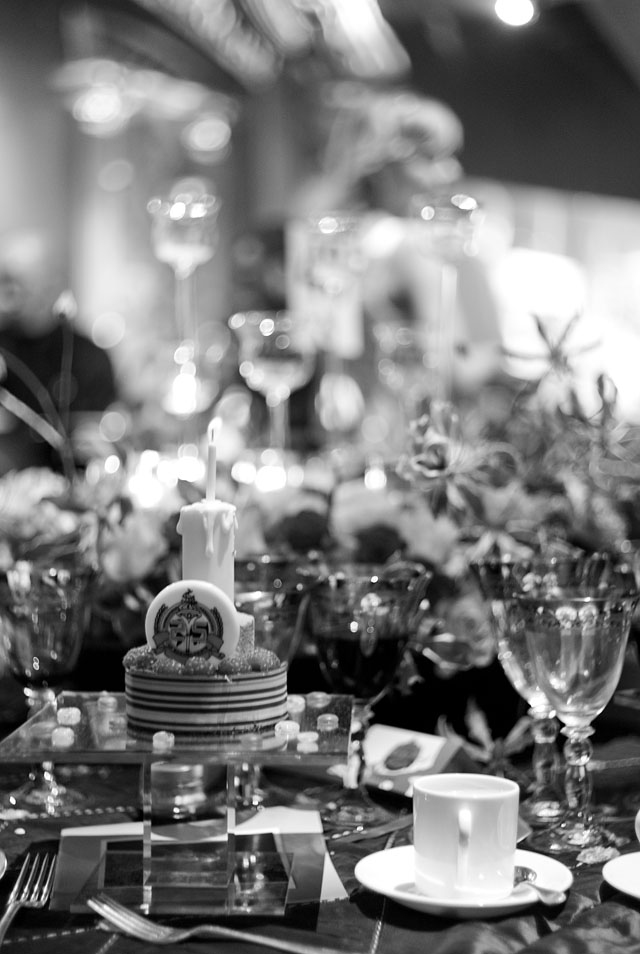
Table decoration with Leica M9 and 50mm Summicron-M f/2.0 @ f/2.0, 800 ISO, 1/20 second. Shot as black and white JPG + color DNG in camera.
| |
|
|
|
|
| |
Buy the new eBook
"A Little Book on Photography"
by Thorsten von Overgaard |
|
| |
|
|
|
|
| |

Order now - Instant delivery.
More info
★
★
★
★
★
★ |
|
It's a humorous understatement to call this
new eBook by Thorsten Overgaard for
"A Little Book on Photography".
It's a grand book, a history lesson, life experience, a biography and poetry book and brilliant photo book!
All in one beautiful package of 180 pages
to fire you up and get you to love
photography ... unconditionally!
"A Little Book on Photography"
eBook for computer, Kindle and iPad.
New release March 2017.
Intro price only $47 - 180 pages.
| |
|
|
| |
Buy Now

Instant Delivery |
|
| |
|
|

|
|
| |
|
|

Shot as black and white JPG + color DNG in camera.
The dSLR and Leica S2 seem to be assignment cameras, the ones that you use to make "result ensured" photographs, but those cameras are not the ones you wear all the time or sneak around with and take unnoticed shots with. And if the Leica M9 can produce results as the dSLR, then what is there to think about? It's a matter of what you will be missing, if anything. And I can only guess, more than me are having this conversation with themselves.
I did one week in London with seven pairs of socks, five t-shirts and one small camera over the shoulder. You can't help imagine how life would be if it was always that simple!

Shot as black and white JPG + color DNG in camera.
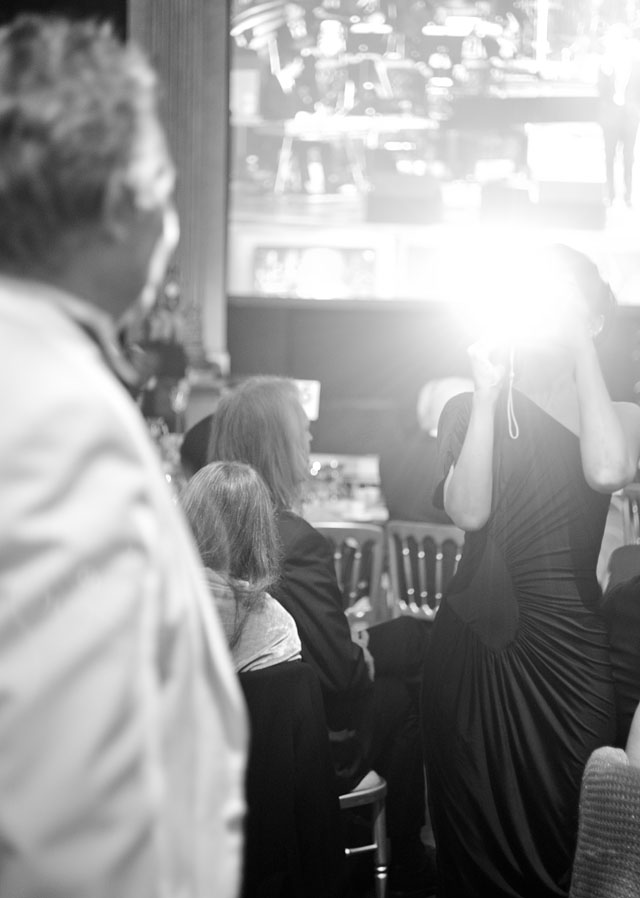
Shot as black and white JPG + color DNG in camera.

Shot as black and white JPG + color DNG in camera.
The Classic Lenses
I think, that when we get into the Leica M9 drill, we'll get over our imagined inferiority to high-ISO performers such as Canon 5D Mark II and Nikon D3 and out constant hunt for razor-sharp 100% crops of digital images - and perhaps grow to realize that even the out-of-focus photo can have qualities unmatched by any other camera.

Photo seminar in London with Leica M9 and 50mm Noctilux-M f/1.0 @ f/1.0, 400 ISO, 1/30 second (It's a daylight LED light John is holding. See the Quality of Light article on this).
I think new times call for new lenses, just because there's experiences to be had in using them, and because they are really new and outstanding. But don't throw out the old lenses just yet.

London street with Leica M9 and 35mm Summicron-M f/2.0 (version I anno 1960) @ f/2.0, 200 ISO, 1/500 seconds.
In some instances one probably won't be able to tell which lens was used, and in many cases it might even be unimportant if it was a Leica lens. But when taken to the extremes, such as shooting straight against the light, the new Leica ASPH lenses handles light with a control and clarity which is unmatched. In the older designs the light seems to flow more and create a "milky" effect.

I guess this one could have been done with a lot of lenses. Clear, sharp, detailed, nothing special fingerprint to it really. Leica M9 and 50mm Summicron-M f/2.0 @ f/2.0, 400 ISO, 1/40 second.
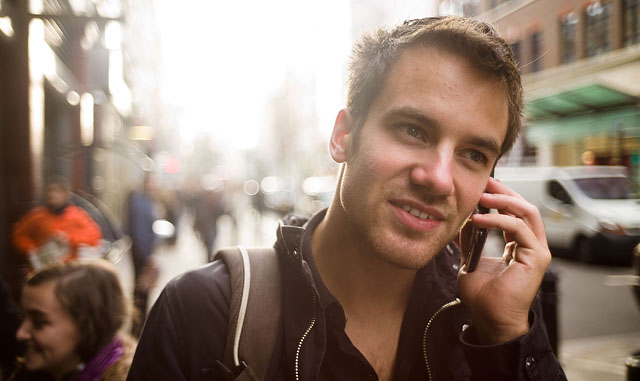
Leica M9 and 35mm Summicron-M f/2.0 @ f/2.0, 200 ISO, 1/180 second. This one is very special, the bokeh and the handling of light. It's actually been improved a great deal in terms of contrast in Lightroom. But as it’s said, that's the "fashion look, you pay thousands to get someone to create that look in photoshop." Well, no need to anymore, just find an old lens and a new Leica M9.

Here's the after/before adjustment in Lightroom 2.4 (exposure -1/3 stop, higher brightness and higher contrast (+84), blacks added (+29), recovery (+20), orange (-31) and red (-14) saturation reduced.
For most M9 photos, using Lightroom without any specific M9 profile but the one mentioned on page 1 of this review, I desaturate orange and red (and often increased yellow luminance) in a level as the above, rather then lighten, add contrast and use recovery to a lesser degree than the above. But black, lighten, contrast and recovery often go hand in hand as a set (and often in the way that exposure is reduced a bit so as to leave space for brightening).
(There is more about editing black & white photos from the Leica M9 on page 16 of this article)
Advertisement:


Leica M9 with 35mm Summicron-M f/2.0 @ f/2.0, 400 ISO, 1/2 second.
I bring my camera
On a final note, and I've noticed I'm not the only one: I bring my camera almost all the time. I've actually started saying: "I wear my Leica M9" which implies both a fashion statement, but also that I have it around the neck like a shirt. Hence the seven socks, five t-shirts and one Leica M9.
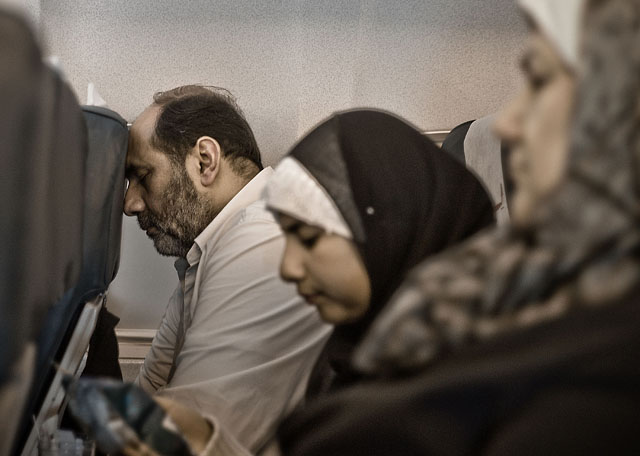
I always bring my camera gear and hand luggage on airplanes but never use it. But the M9 is slightly different, and this one is from the plane home from London. Leica M9 and 35mm Summicron-M f/2.0, 400 ISO, 1/40 second.

CONTINUES ON PAGE 5 --->
Thorsten Overgaard
October 2009. Last edited March 2012.
Index of pages covering Leica M9, Leica M9-P, Leica M-E, Leica M Monochrom and Leica M Type 240:

As always, feel free to e-mail me at thorsten@overgaard.dk with suggestions, ideas and questions. |
![]()
